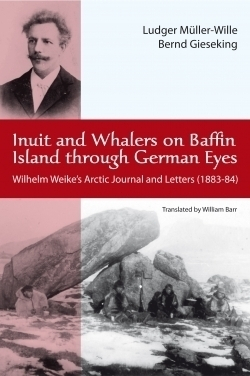Inuit and Whalers on Baffin Island through German Eyes
Wilhelm Weike's Arctic Journal and Letters (1883-84)
Every challenging travel expedition necessitates a host of mundane housekeeping tasks. While most first-person accounts include episodes of pain and suffering, fatigue, and even boredom, the more ordinary aspects may be given short shrift if such chores are the responsibility of someone other than the explorer of record. Inuit and Whalers on Baffin Island through German Eyes corrects the usual picture. It widens the view by looking through the eyes of a servant, young Wilhelm Weike, who accompanied equally young anthropologist-to-be Franz Boas to the Arctic in the late nineteenth century.
Weike was young, healthy, and a trusted employee of the father of Franz Boas, financial backer of his son’s expedition. Literate in German and blessed with a cheerful, curious, observant nature, Weike was also a willing worker and clever handyman. His journal, kept at the request of Franz Boas and never originally intended by either man for publication, is extraordinary not because (despite its English title) it depicts the Arctic “through German eyes” but because it was written by a gardener and domestic servant. Even the educated Boas could not be fully prepared for everything he would find in the world of the Inuit, so how much more astonishing the Arctic world must have seemed to Wilhelm Weike, we might think. Yet Weike’s journal entries show a young man who took each day as it came, performing his tasks and deriving pleasure and diversion where he found it.
He prepared meals, made bullets, packed, unpacked, and repacked shipping boxes, built and traded and did the laundry and made endless pots of coffee. He also liked going for walks (unfazed by subzero temperatures), enjoyed musical evenings, and wrote letters home, in addition to keeping his journal. All in all, he seems to have taken his adventure in stride, even when recording new experiences.
Weike’s journal and letters do not stand alone. Introductory material and extensive background on both Boas and Weike and on the Arctic during the period add to and amplify the first-person account. Inuit and Whalers on Baffin Island through German Eyes greatly enriches our picture of the intermingling of indigenous and European cultures in the late nineteenth-century Arctic.
Reviewed by
Pamela Grath
Disclosure: This article is not an endorsement, but a review. The publisher of this book provided free copies of the book and paid a small fee to have their book reviewed by a professional reviewer. Foreword Reviews and Clarion Reviews make no guarantee that the publisher will receive a positive review. Foreword Magazine, Inc. is disclosing this in accordance with the Federal Trade Commission’s 16 CFR, Part 255.

